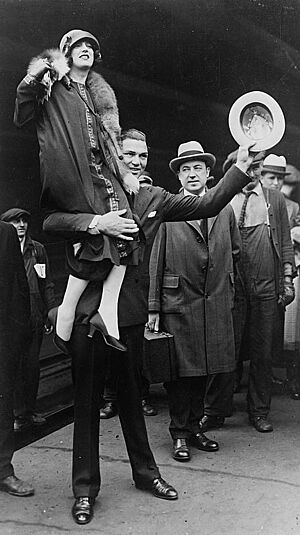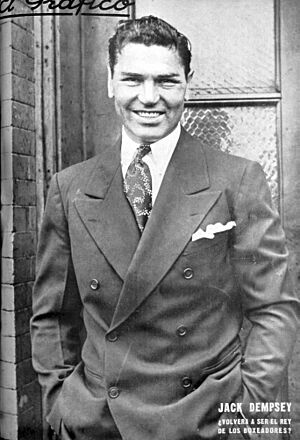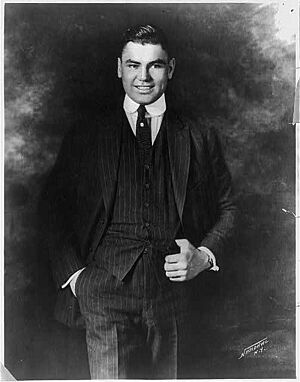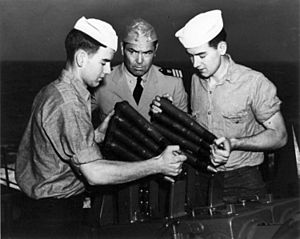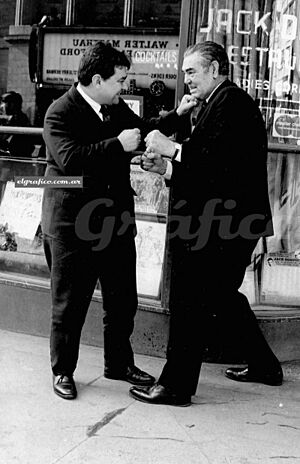Jack Dempsey facts for kids
Quick facts for kids Jack Dempsey |
|
|---|---|
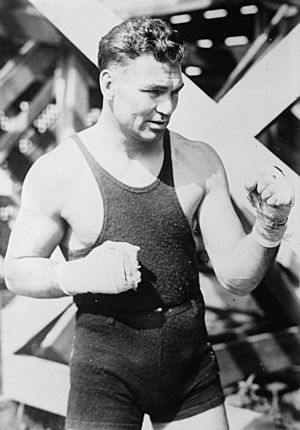 |
|
| Statistics | |
| Real name | William Harrison Dempsey |
| Nickname(s) |
|
| Rated at |
|
| Height | 6 ft 1 in |
| Reach | 73 in |
| Born | June 24, 1895 Manassa, Colorado, U.S. |
| Died | May 31, 1983 (aged 87) New York City, U.S. |
| Stance | Orthodox |
| Boxing record | |
| Total fights | 85 |
| Wins | 68 |
| Wins by KO | 53 |
| Losses | 6 |
| Draws | 9 |
William Harrison "Jack" Dempsey (born June 24, 1895 – died May 31, 1983) was a famous American professional boxer. People knew him by his nicknames, Kid Blackie and The Manassa Mauler. He boxed from 1914 to 1927 and was the world heavyweight boxing champion from 1919 to 1926.
Jack Dempsey was a huge star in the 1920s. His exciting fighting style and powerful punches made him one of the most popular boxers ever. Many of his fights broke records for how much money they made and how many people watched. He even helped start live broadcasts of sports events on the radio. The Ring magazine ranks him among the best heavyweights and top punchers of all time. He is also a member of the International Boxing Hall of Fame.
Contents
Jack Dempsey's Early Life and Boxing Start
Growing Up and Finding Boxing
William Harrison Dempsey was born in Manassa, Colorado, in 1895. He grew up in Colorado and West Virginia. His family moved often because his father had trouble finding work. Jack left elementary school at age 16 to help earn money.
He often traveled by riding on trains and slept in hobo camps. To get money, Dempsey sometimes went into saloons and challenged people to fights. He almost always won these barroom brawls.
Becoming "Jack Dempsey"
In his early boxing days, Dempsey often used the name "Kid Blackie." Later, he started fighting as "Young Dempsey." He first used the name "Jack Dempsey" in 1914. His brother, Bernie, sometimes used that name too, because they admired another boxer named Jack "Nonpareil" Dempsey.
In his first fight as "Jack Dempsey," he fought George Copelin. Copelin was much heavier than Dempsey. But Dempsey knocked Copelin down many times and won the fight. This showed everyone how tough he was.
After this, Dempsey won many fights by knockout. He fought in Utah and Nevada. When the World War I started in 1917, Dempsey worked in a shipyard. Some people criticized him for not joining the army. But it was later shown that he had registered and was excused because he had a dependent wife.
Becoming World Heavyweight Champion

As Dempsey became more famous, he fought tough opponents. One was Fireman Jim Flynn, who had once knocked Dempsey out. But Dempsey later knocked Flynn out in the first round. He also beat Gunboat Smith three times.
In 1918, Dempsey had a great year, winning 15 out of 17 matches. He beat important boxers like Battling Levinsky and Billy Miske. In 1919, he won five fights in a row by knockout in the first round.
Winning the World Title
On July 4, 1919, Jack Dempsey fought Jess Willard for the world heavyweight title. Willard was the champion and much bigger than Dempsey. But Dempsey was incredibly aggressive. He knocked Willard down seven times in the first round. Willard's corner stopped the fight after the third round, and Dempsey became the new world heavyweight champion.
Defending the Title: Famous Fights
After winning the title, Dempsey became a huge celebrity. He appeared in movies and did public events. He didn't defend his title until September 1920, when he knocked out Billy Miske in three rounds.
His next defense was against Bill Brennan in December 1920. Brennan was ahead on points, and Dempsey was bleeding. But Dempsey came back and stopped Brennan in the 12th round.
Jack Dempsey vs. Georges Carpentier
Dempsey's next big fight was against Georges Carpentier in July 1921. Carpentier was a French war hero and very popular. This fight was a huge event, known as "the Fight of the Century." It was the first boxing match to make over a million dollars. Also, it was the first sports event broadcast live on national radio!
About 91,000 people watched the fight. Carpentier hit Dempsey hard in the second round. But Dempsey fought back and won the match in the fourth round.
Dempsey defended his title again in July 1923 against Tommy Gibbons, winning by decision.
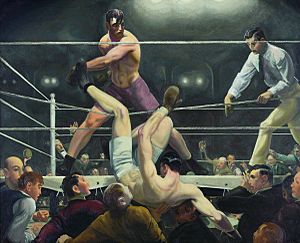
His last successful title defense was in September 1923 against Luis Ángel Firpo. This fight was also very exciting. Firpo was knocked down many times but kept getting up. At one point, Firpo knocked Dempsey out of the ring! Writers at ringside helped Dempsey get back in. Dempsey eventually knocked Firpo out in the second round. This fight was also broadcast live on radio to Argentina.
These fights made Dempsey one of the richest athletes in the world. He even appeared on the cover of Time magazine.
Time Away and Losing the Title
After the Firpo fight, Dempsey didn't defend his title for three years. During this time, he made money from boxing shows, product ads, and movies. He also traveled a lot and enjoyed his fame. He married actress Estelle Taylor in 1925.
Losing the Championship
In September 1926, Dempsey fought Gene Tunney in Philadelphia. Tunney was a former U.S. Marine and had only lost once. Even though Dempsey had been inactive, he was still the favorite.
But Tunney surprised everyone and won the fight. Dempsey lost his title on points after 10 rounds. When he returned to his dressing room, he famously told his wife, "Honey, I forgot to duck."
The "Long Count" Rematch
Dempsey wanted to win his title back. He fought Jack Sharkey in July 1927 to earn a chance to fight Tunney again. Dempsey knocked Sharkey out in the seventh round, but it was controversial. Sharkey complained Dempsey hit him below the belt. While Sharkey was complaining to the referee, Dempsey landed a powerful punch and knocked him out.
The rematch with Gene Tunney happened in Chicago on September 22, 1927. This fight was even bigger than the others, making a record $2 million. Millions of people listened on the radio.
In the seventh round, Dempsey knocked Tunney down. But there was a new rule: when a fighter knocks down an opponent, they must go to a neutral corner right away. Dempsey didn't go to the neutral corner immediately. The referee had to guide him, which gave Tunney extra time to recover. Tunney was down for 14 seconds, but the referee only started counting when Dempsey moved. Tunney got up at the count of 9. This became known as "The Long Count Fight." Tunney went on to win the fight by decision, keeping his title.
Life After Boxing
After the Tunney rematch, Dempsey retired from professional boxing. But he still did many exhibition matches, which are like friendly shows, in the 1930s. He became known for being a kind person and helping others.
In 1935, Dempsey opened "Jack Dempsey's Restaurant" in New York City. It was a very popular place and stayed open until 1974.
Serving in World War II
When the United States entered World War II, Dempsey joined the Coast Guard Reserve. He became an officer and helped with physical training. He also visited military camps and hospitals and helped with war bond drives. He was on ships during the war, including for the invasion of Okinawa. He left active duty in 1945.
Later Years and Legacy
Dempsey wrote a book about boxing called Championship Fighting: Explosive Punching and Aggressive Defense. He also became good friends with his former opponents, Gene Tunney and Harry Wills.
Jack Dempsey was one of the first people inducted into The Ring magazine's Boxing Hall of Fame in 1954. He was also part of the first group inducted into the International Boxing Hall of Fame in 1990. His boxing style was known for constant movement and powerful attacks.
Jack Dempsey passed away on May 31, 1983, at the age of 87, in New York City. He is buried in Southampton, New York.
Jack Dempsey's Boxing Record
| 85 fights | 64 wins | 6 losses |
| By knockout | 53 | 1 |
| By decision | 10 | 5 |
| By disqualification | 1 | 0 |
| Draws | 9 | |
| Newspaper decisions/draws | 6 | |
Note: Some early fights were called "no decision" bouts, meaning judges didn't score them. These are not counted in the official win/loss/draw record.
| No. | Result | Record | Opponent | Type | Round, time | Date | Location | Notes |
|---|---|---|---|---|---|---|---|---|
| 84 | Loss | 64–6–9 (6) | Gene Tunney | UD | 10 | 22 Sep 1927 | Soldier Field, Chicago, Chicago, Illinois, U.S. | For NYSAC, NBA, and The Ring heavyweight titles |
| 83 | Win | 63–5–9 (6) | Jack Sharkey | KO | 7 (15), 0:45 | 21 Jul 1927 | Yankee Stadium, New York City, New York, U.S. | |
| 82 | Loss | 62–5–9 (6) | Gene Tunney | UD | 10 | 23 Sep 1926 | Sesquicentennial Stadium, Philadelphia, Pennsylvania, U.S. | Lost NYSAC, NBA, and The Ring heavyweight titles |
| 81 | Win | 62–4–9 (6) | Luis Ángel Firpo | TKO | 2 (15), 0:57 | 14 Sep 1923 | Polo Grounds, New York City, New York, U.S. | Retained NYSAC, NBA, and The Ring heavyweight titles |
| 80 | Win | 61–4–9 (6) | Tommy Gibbons | PTS | 15 | 4 Jul 1923 | Arena, Shelby, Montana, U.S. | Retained NYSAC, NBA, and The Ring heavyweight titles |
| 79 | Win | 60–4–9 (6) | Georges Carpentier | KO | 4 (12) | 2 Jul 1921 | Boyle's Thirty Acres, Jersey City, New Jersey U.S. | Retained NYSAC and NBA heavyweight titles |
| 78 | Win | 59–4–9 (6) | Bill Brennan | KO | 12 (15), 1:57 | 14 Dec 1920 | Madison Square Garden, New York City, New York, U.S. | Retained NYSAC heavyweight title |
| 77 | Win | 58–4–9 (6) | Billy Miske | KO | 3 (10), 1:13 | 6 Sep 1920 | Floyd Fitzsimmons Arena, Benton Harbor, Michigan, U.S. | Retained NYSAC heavyweight title |
| 76 | Win | 57–4–9 (6) | Jess Willard | RTD | 3 (12) | 4 Jul 1919 | Bay View Park Arena, Toledo, Ohio, U.S. | Won world heavyweight title |
| 75 | Win | 56–4–9 (6) | Tony Drake | KO | 1 | 2 Apr 1919 | New Haven, Connecticut, U.S. | |
| 74 | Win | 55–4–9 (6) | Eddie Smith | KO | 1 | 13 Feb 1919 | Altoona, Pennsylvania, U.S. | |
| 73 | Win | 54–4–9 (6) | Kid Harris | KO | 1 | 29 Jan 1919 | Easton, Pennsylvania, U.S. | |
| 72 | Win | 53–4–9 (6) | Kid Harris | KO | 1 | 23 Jan 1919 | Reading, Pennsylvania, U.S. | |
| 71 | Win | 52–4–9 (6) | Big Jack Hickey | KO | 1 | 20 Jan 1919 | Harrisburg, Pennsylvania, U.S. | |
| 70 | Win | 51–4–9 (6) | Jack Maguire | KO | 1 | 16 Jan 1919 | Trenton, New Jersey, U.S. | |
| 69 | Win | 50–4–9 (6) | Gunboat Smith | KO | 2 (8) | 16 Dec 1918 | Broadway Auditorium, Buffalo, New York, U.S. | |
| 68 | Win | 49–4–9 (6) | Carl Morris | KO | 1 (20), 1:00 | 16 Dec 1918 | Louisiana Auditorium, New Orleans, Louisiana, U.S. | |
| 67 | Win | 48–4–9 (6) | Billy Miske | NWS | 6 | 28 Nov 1918 | Olympia Athletic Club, Philadelphia, Pennsylvania, U.S. | |
| 66 | Win | 48–4–9 (5) | Dan Flynn | KO | 1 (6), 2:16 | 18 Nov 1918 | Olympia Athletic Club, Philadelphia, Pennsylvania, U.S. | |
| 65 | Win | 47–4–9 (5) | Battling Levinsky | KO | 3 (6) | 6 Nov 1918 | Olympia Athletic Club, Philadelphia, Pennsylvania, U.S. | |
| 64 | Win | 46–4–9 (5) | Jack Moran | KO | 1 (10), 1:10 | 14 Sep 1918 | Moana Springs Arena, Reno, Nevada, U.S. | |
| 63 | Loss | 45–4–9 (5) | Willie Meehan | PTS | 4 | 13 Sep 1918 | San Francisco Civic Auditorium, San Francisco, California, U.S. | |
| 62 | Win | 45–3–9 (5) | Terry Kellar | TKO | 5 (15) | 24 Aug 1918 | Westwood Field Gym, Dayton, Ohio, U.S. | |
| 61 | Win | 44–3–9 (5) | Fred Fulton | KO | 1 (8), 0:23 | 27 Jul 1918 | Harrison Park, Harrison, New Jersey, U.S. | |
| 60 | Win | 43–3–9 (5) | Dan Flynn | KO | 1 (10) | 6 Jul 1918 | Municipal Auditorium, Atlanta, Georgia, U.S. | |
| 59 | Win | 42–3–9 (5) | Bob Devere | KO | 1 (12) | 4 Jul 1918 | Joe Becker Stadium, Joplin, Missouri, U.S. | |
| 58 | Win | 41–3–9 (5) | Tom McCarty | KO | 1 (12), 0:30 | 1 Jul 1918 | Tulsa Convention Hall, Tulsa, Oklahoma, U.S. | |
| 57 | Win | 40–3–9 (5) | Arthur Pelkey | KO | 1 (15), 1:00 | 29 May 1918 | Stockyards Stadium, Denver, Colorado, U.S. | |
| 56 | Win | 39–3–9 (5) | Dan Ketchell | KO | 2 (10) | 22 May 1918 | Excelsior Springs, Missouri, U.S. | |
| 55 | Win | 38–3–9 (5) | Billy Miske | NWS | 10 | 3 May 1918 | Auditorium, Saint Paul, Minnesota, U.S. | |
| 54 | Win | 38–3–9 (4) | Tom Riley | KO | 1 (15) | 25 Mar 1918 | Southwest Athletic Club, Joplin, Missouri, U.S. | |
| 53 | Win | 37–3–9 (4) | Fred Saddy | KO | 1 (8) | 16 Mar 1918 | Phoenix Athletic Club, Memphis, Tennessee, U.S. | |
| 52 | Win | 36–3–9 (4) | Bill Brennan | TKO | 6 (10) | 25 Feb 1918 | Milwaukee Auditorium, Milwaukee, Wisconsin, U.S. | |
| 51 | Win | 35–3–9 (4) | Fireman Jim Flynn | KO | 1 (10), 1:10 | 14 Feb 1918 | Fort Sheridan, Illinois, U.S. | |
| 50 | Win | 34–3–9 (4) | Carl Morris | DQ | 6 (10) | 2 Feb 1918 | Broadway Auditorium, Buffalo, New York, U.S. | |
| 49 | Win | 33–3–9 (4) | Homer Smith | KO | 1 (10), 1:15 | 24 Jan 1918 | Racine, Wisconsin, U.S. | |
| 48 | Win | 32–3–9 (4) | Carl Morris | PTS | 4 | 2 Nov 1917 | Dreamland Rink, San Francisco, California, U.S. | |
| 47 | Win | 31–3–9 (4) | Gunboat Smith | PTS | 4 | 2 Oct 1917 | Recreation Park, San Francisco, California, U.S. | |
| 46 | Win | 30–3–9 (4) | Bob McAllister | PTS | 4 | 26 Sep 1917 | Arena, Emeryville, California, U.S. | |
| 45 | Win | 29–3–9 (4) | Charley Miller | TKO | 1 (4) | 19 Sep 1917 | Arena, Emeryville, California, U.S. | |
| 44 | Win | 28–3–9 (4) | Willie Meehan | TKO | 1 (4) | 19 Sep 1917 | Arena, Emeryville, California, U.S. | |
| 43 | Draw | 27–3–9 (4) | Willie Meehan | PTS | 4 | 7 Sep 1917 | Dreamland Rink, San Francisco, California, U.S. | |
| 42 | Draw | 27–3–8 (4) | Willie Meehan | PTS | 4 | 10 Aug 1917 | Dreamland Rink, San Francisco, California, U.S. | |
| 41 | Win | 27–3–7 (4) | Al Norton | KO | 1 (4) | 1 Aug 1917 | Arena, Emeryville, California, U.S. | |
| 40 | Win | 26–3–7 (4) | Willie Meehan | PTS | 4 | 25 Jul 1917 | Arena, Emeryville, California, U.S. | |
| 39 | Draw | 25–3–7 (4) | Al Norton | PTS | 4 | 11 Apr 1917 | West Oakland Club, Oakland, California, U.S. | |
| 38 | Loss | 25–3–6 (4) | Willie Meehan | PTS | 4 | 28 Mar 1917 | Arena, Emeryville, California, U.S. | |
| 37 | Draw | 25–2–6 (4) | Al Norton | PTS | 4 | 21 Mar 1917 | West Oakland Club, Oakland, California, U.S. | |
| 36 | Loss | 25–2–5 (4) | Fireman Jim Flynn | KO | 1 (15), 0:25 | 13 Feb 1917 | Trocadero Hall, Murray, Utah, U.S. | |
| 35 | Win | 25–1–5 (4) | Young Hector | KO | 2 | 29 Nov 1916 | The Rink, Salida, Colorado, U.S. | |
| 34 | Win | 24–1–5 (4) | Dick Gilbert | PTS | 10 | 16 Oct 1916 | Salt Lake Theater, Salt Lake City, Utah, U.S. | |
| 33 | Win | 23–1–5 (4) | Terry Kellar | PTS | 10 | 7 Oct 1916 | Bijo Hall, Ely, Nevada, U.S. | |
| 32 | Win | 22–1–5 (4) | Young Hector | RTD | 3 (15) | 28 Sep 1916 | Fire Hall, Murray, Utah, U.S. | |
| 31 | Draw | 21–1–5 (4) | John Lester Johnson | NWS | 10 | 14 Jul 1916 | Harlem Sporting Club, Harlem, New York, U.S. | |
| 30 | Win | 21–1–5 (3) | Bert Kenny | NWS | 10 | 8 Jul 1916 | Fairmont Athletic Club, Bronx, New York, U.S. | |
| 29 | Win | 21–1–5 (2) | Andre Anderson | NWS | 10 | 24 Jun 1916 | Fairmont Athletic Club, Bronx, New York, U.S. | |
| 28 | Win | 21–1–5 (1) | Bob York | KO | 4 (6) | 30 May 1916 | Eko Theatre, Price, Utah, U.S. | For Pacific Coast light-heavyweight title |
| 27 | Win | 20–1–5 (1) | Dan Ketchell | TKO | 3 (10) | 17 May 1916 | Mozart Theatre, Provo, Utah, U.S. | |
| 26 | Win | 19–1–5 (1) | Terry Kellar | PTS | 10 | 3 May 1916 | Alhambra Theatre, Ogden, Utah, U.S. | |
| 25 | Win | 18–1–5 (1) | Joe Bonds | PTS | 10 | 8 Apr 1916 | Bijo Hall, Ely, Nevada, U.S. | |
| 24 | Win | 17–1–5 (1) | George Christian | KO | 1 (15) | 17 Mar 1916 | Eko Theatre, Price, Utah, U.S. | |
| 23 | Win | 16–1–5 (1) | Cyril Kohen | KO | 4 (6) | 9 Mar 1916 | Mozart Theatre, Provo, Utah, U.S. | |
| 22 | Win | 15–1–5 (1) | Boston Bearcat | KO | 1 | 23 Feb 1916 | Armory, Ogden, Utah, U.S. | |
| 21 | Win | 14–1–5 (1) | Jack Downey | KO | 2 | 21 Feb 1916 | Grand Theater, Salt Lake City, Utah, U.S. | |
| 20 | Win | 13–1–5 (1) | Swede Johnson | KO | 2 | 5 Feb 1916 | Bijo Hall, Ely, Nevada, U.S. | |
| 19 | Win | 12–1–5 (1) | Johnny Sudenberg | KO | 2 | 1 Feb 1916 | Bijo Hall, Ely, Nevada, U.S. | |
| 18 | Win | 11–1–5 (1) | Jack Gillian | TKO | 1 (4) | 20 Dec 1915 | Grand Theater, Salt Lake City, Utah, U.S. | |
| 17 | Draw | 10–1–5 (1) | Jack Downey | PTS | 4 | 13 Dec 1915 | Grand Theater, Salt Lake City, Utah, U.S. | |
| 16 | Win | 10–1–4 (1) | George Coplen | KO | 6 (10) | 19 Nov 1915 | Lyric Opera House, Cripple Creek, Colorado, U.S. | |
| 15 | Win | 9–1–4 (1) | Andy Malloy | KO | 3 (10) | 23 Oct 1915 | Moose Hall, Montrose, Colorado, U.S. | |
| 14 | Win | 8–1–4 (1) | Andy Malloy | NWS | 10 | 7 Oct 1915 | Gem Theatre, Durango, Colorado, U.S. | |
| 13 | Win | 8–1–4 | Fred Woods | KO | 4 | 23 Sep 1915 | Moose Hall, Montrose, Colorado, U.S. | |
| 12 | Draw | 7–1–4 | Johnny Sudenberg | PTS | 10 | 11 Jun 1915 | Airdome, Tonopah, Nevada U.S. | |
| 11 | Draw | 7–1–3 | Johnny Sudenberg | PTS | 10 | 31 May 1915 | Hippodrome, Goldfield, Nevada U.S. | |
| 10 | Win | 7–1–2 | Emmanuel Campbell | TKO | 4 (4) | 26 Apr 1915 | Airdrome Arena, Reno, Arizona, U.S. | |
| 9 | Loss | 6–1–2 | Jack Downey | PTS | 10 | 5 Apr 1915 | Garrick Theater, Salt Lake City, Utah, U.S. | |
| 8 | Win | 6–0–2 | Chief Gordon | KO | 6 | 1 Apr 1915 | Utah, U.S. | |
| 7 | Win | 5–0–2 | John Pierson | KO | 7 | 3 Mar 1915 | Utah, U.S. | |
| 6 | Draw | 4–0–2 | Chief Geronimo | PTS | 4 | 26 Feb 1915 | Pocatello, Idaho, U.S. | |
| 5 | Win | 4–0–1 | Joe Lyons | KO | 9 | 2 Feb 1915 | Utah, U.S. | |
| 4 | Win | 3–0–1 | Battling Johnson | KO | 1 | Jan 1915 | Utah, U.S. | |
| 3 | Win | 2–0–1 | Billy Murphy | KO | 1 (4) | 30 Nov 1914 | Garrick Theater, Salt Lake City, Utah, U.S. | |
| 2 | Win | 1–0–1 | Young Hancock | KO | 1 (4) | 2 Nov 1914 | Garrick Theater, Salt Lake City, Utah, U.S. | |
| 1 | Draw | 0–0–1 | Young Herman | PTS | 6 | 18 Aug 1914 | Ramona Athletic Club Arena, Colorado Springs, Colorado, U.S. |
Published Works by Jack Dempsey
- How to Fight Tough (1942)
- Jack Dempsey's Championship Fighting: Explosive Punching and Aggressive Defense (1950)
- Round by Round (1940)
- Dempsey By The Man Himself As Told To Bob Considine and Bill Slocum (1960)
- Dempsey: The Autobiography of Jack Dempsey (1977)
See also
 In Spanish: Jack Dempsey para niños
In Spanish: Jack Dempsey para niños
- List of heavyweight boxing champions



